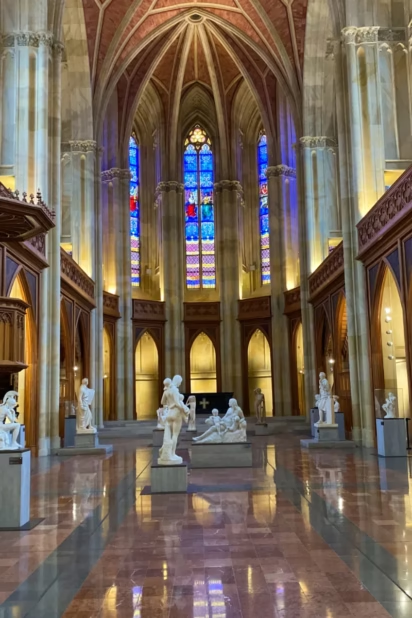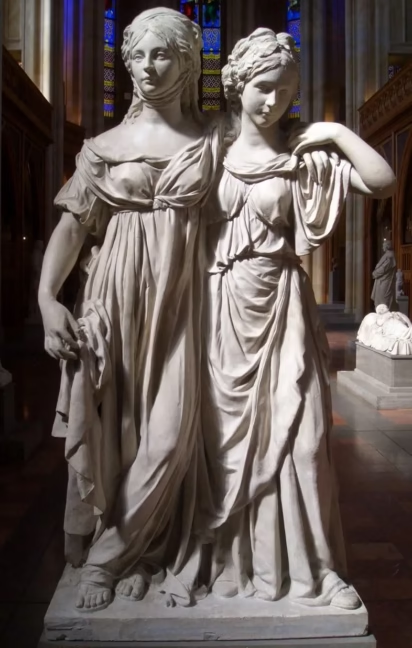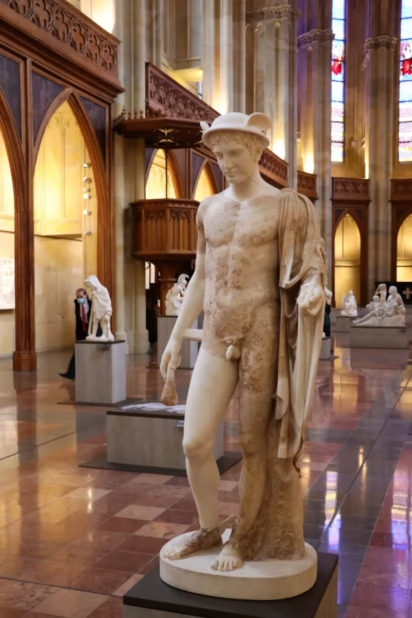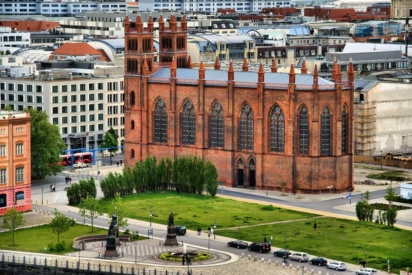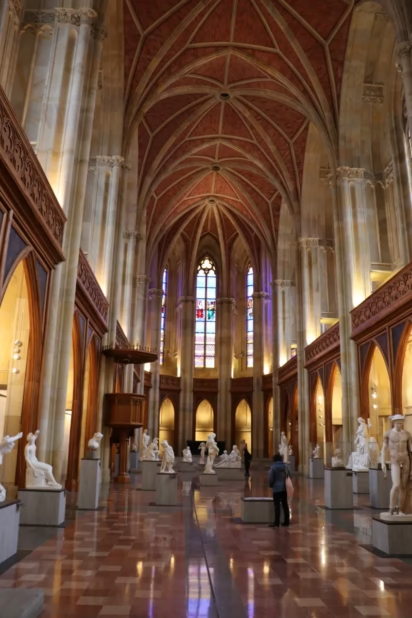Visit the Friedrichswerdersche Kirche in Berlin for a free exhibition of the 19th-century German sculptures of the Alte Nationalgalerie.

The brick neo-gothic Friedrichswerdersche Kirche in Berlin provides a spectacular setting for the Ideal and Form permanent exhibition of 19th-century sculptures by artists associated with the Berliner Bildhauerschule (Berlin school of sculptors). Around 50 works are on display including marble statues and busts, plaster artist models, and a few bronzes by major German artists including Johann Gottfried Schadow, Emil Wolff, Christian Daniel Rauch, Artur Volkmann, and Elisabet Ney. Admission to the exhibition is free.
Ideal and Form: 19th-Century Sculptures from the Nationalgalerie Collection
The 50 sculptures on display in the Ideal und Form permanent exhibition in the Friedrichswerdersche Kirche in Berlin are from the unrivaled collection of German sculptures of the Nationalgalerie. These works are from the long 19th century, i.e. from the French Revolution (1789) to the First World War (1914-1918) or in Berlin art historical terms, from the Schinkel period (Schinkelzeit) to the end of the German Empire (Kaiserreich).
The exhibition explains the development of sculpting in the Berlin milieu from the foundation of the first court sculptor school in Germany by Prussian King Frederick the Great in 1747 to the early 20th century and the start of the modern era.
The name Friedrichswerdersche Kirche is for many easier to explain than to write or pronounce. Werder is the name of the island that the church is on. The name of the island was changed to Friedrichswerder in honor of the Great Elector Friedrich Wilhelm of Brandenburg (1620-1688). “Sche” is basically the apostrophe “s” to link it to church (Kirche), which is confusing as it has only been used as exhibition space by the Nationalgalerie since reconstruction in the 1980s.
Sculptures in the Friedrichswerdersche Kirche
The sculptures displayed in the Friedrichswerdersche Kirche are grouped in main themes that include:
The Beginning of Berlin School of Sculptors — the French in Berlin

Frederick the Great was a Francophile in language and thought and his choice for the first directors of the sculpture school were naturally French artists who introduced the latest techniques of working with marble and bronze to Prussia. The exhibition thus starts with Jean-Pierre Antoine Tassaert’s bronze bust of Moses Mendelssohn and the much-studied bronze Hyacinth by Francois-Joseph Bosio.
Berlin Sculptors in Rome — Between Antiquity and the Modern
Scared off by the chaos of the French Revolution, the focus for many artists moved to Rome, which for much of the 19th century was the center of artistic schooling for sculptors. A study of the antiquities was considered essential. Many artists studied in Rome while some such as Emil Wolff and Ridolfo Schadow (like the great Danish sculptor Bertel Thorvaldsen) spent almost their entire lives in Rome.
Johann Gottfried Schadow
Johann Gottfried Schadow (1784-1850) was the first highly successful Berlin sculptor of the classical era. Several of his works, as well as some by his son Ridolfo (1786-1822), are on display. The most praised Schadow sculpture in the exhibition is the plaster working model of Princesses Luise and Friederike of Prussia (Doppelstandbild der Prinzessinnen Luise und Friederike von Preussen).
This original model from 1795 is being restored — meanwhile, visitors may climb on the plinth and try to copy the royal pose. The restored plaster model, together with the marble version made in 1797, will form the core of the Berührende Formen / Moving Shapes — Johann Gottfried Schadow temporary exhibition in the Alte Nationalgalerie from 21 October 2022 to 19 February 2023. (“Moving” refers to the emotion experienced when viewing the sculptures, no mobiles are on display) Afterward, the model will return to the Friedrichswerdersche Kirche and the marble to the sculpture collection in the Alte Nationalgalerie.
Schadow’s most-famous sculpture in Berlin is of course on permanent free display — the Quadriga on top of the Brandenburg Gate.
Other artists with works in the classical style include Katharina Felder, Christian Daniel Rauch, and Christian Friedrich Tieck. Many are figures from mythology and heroes from antiquity but Heinrich Kümmel’s Fischerknabe (Boy Fishing) was inspired by Goethe’s poem “Der Fischer”.
Several works by Emil Wolff are on display. His Hermes (1824) is a restoration of a sculpture from antiquity — something that was a helpful earner for artists trying to make a living in 18th and 19th century Italy. Of his own marbles, Der Winter (Winter), 1845, is probably the most popular sculpture in the exhibition. It is a boy dressed in a lion skin cloak leaning on a club — two attributes of Hercules — but as an allegory of winter. Winter was already a best-seller in Wolff’s lifetime and sold either as solo sculpture or as a set with all four seasons.
Export Success — Berlin in England the USA
By the mid-century, Prussian sculptors still studied in Italy but increasingly Renaissance and Baroque sculptures by amongst others Michelangelo and Bernini served as inspiration rather than the classics of antiquity. Many Berlin artists successfully sold not only to German patrons but also to England and the USA. German immigrants to the US not only increased the market but some artists also settled across the Atlantic, including the famous female sculptor Elisabeth Ney — note her Bismarck on the upper level.
Two interesting sculptures showing Eva with her children are by Adolf Brütt and by Reinhold Begas. In the latter, toddler Cain is trying to kick a suckling baby Abel.
Renewal — Berlin, Rome, Paris

Towards the end of the 19th century, German sculptors still studied in Rome although Paris, especially due to the influence of Rodin, became increasingly popular. Sculptors moved away from classic themes and stylistic portrayals of figures from classical mythology and heroes.
Rather than Hermes, Amor, Achilles, or Hercules, Adolf von Hildebrand sculpted a simple naked Sleeping Shepherd Boy (Schlafender Hirtenknabe) and Paul Peterich a nude boy (Stehender Knabe) — both artists strongly influenced by Renaissance works they studied in Florence. Artur Volkmann moved away from the ideal of a classic white marble sculpture in his Naked Youth (Nackter Jüngling) that is partly painted — due to the apple, he is often described as Paris.
Statues from the Altes Museum in the Friedrichswerdersche Kirche
Several statues originally in the Altes Museum, are portrayals of the leading 19th-century artists of the Berlin School including Rauch, Schadow, and Winckelmann. Three are of Karl Friedrich Schinkel (architect of classical Berlin including this church and the Altes Museum).
The upper floor is mostly visited for the lovely views from the gallery that goes all the way around the nave. However, here is also an exhibition on the planning of this church, as well as ten further sculptures by artists closely associated with Schinkel, including several by Christian Daniel Rauch but also by the internationally famous Bertel Thorvaldsen and Elisabeth Ney.
The five stained-glass windows in the choir are the originals from the early 19th century. They were in storage during the final years of the Second World War and restored to the church during the rebuilding in the 1980s.
Friedrichswerdersche Kirche in Berlin
The Friedrichswerdersche Kirche was designed by the famous Prussian architect Karl Friedrich von Schinkel (1781-1841). He designed several neoclassical buildings in Berlin including the Altes Museum and the Konzerthaus. Despite Crown Prince Friedrich Wilhelm asking for a church in the medieval style, Von Schinkel presented at least three classical designs before agreeing on the Neo-Gothic design his paymaster wanted. This partly explains the narrow but high proportions and a design that reminds of English college chapels and classical monuments rather than German Gothic cathedrals.
The church was erected between 1824 and 1831 — the first prestigious building in brick in Germany since the middle ages. It was heavily damaged during the Second World War and left in ruins until it was rebuilt in a rushed job by the East German regime in time for the 750th anniversary of Berlin in 1987. Repairs were necessary between 1997-2001, and again after 2012 when nearby construction work caused ground movements that damaged the church. It reopened in 2020.
The repaired church closely followed the plans of Von Schinkel and is the only major building in Berlin with the interior decorated as designed by Von Schinkel. This included painting more complicated vaulting onto the ceiling vaults of the nave to increase the impression of height even further.

Friedrichswerdersche Kirche Visitor’s Information
Opening Hours and Tickets
From mid-April 2024, the Friedrichswerdersche Kirche is open Wednesday to Sunday from 10:00 to 17:00 (closing at 18:00 on Saturday and Sunday).
Admission is free. Currently, it is not necessary or even possible to make time-slot reservations.
The Friedrichswerdersche Kirche is close to some of the most popular sights in central Berlin but as it is closely surrounded by several buildings, as it was at the time of original construction, many visitors miss out on seeing this sculpture collection of the Alte Nationalgalerie.
It is located at Werderscher Markt, a long block behind the Kronprinzenpalais on Under den Linden and roughly halfway between the Berliner Schloss (Humboldt Forum) and Bebelsplatz.
More on the Berlin State Museums (Staatliche Museen zu Berlin):
Note new opening times for many Berlin museums in 2025 — several are now closed on both Monday and Tuesday.
Timeslot reservations are sensible (and sometimes needed in busy periods) for the Alte Nationalgalerie, Gemäldegalerie, Neue Nationalgalerie, Neues Museum, and Pergamon – Das Panorama. (The Pergamon Museum itself is closed until 2027!). Timeslots are released only a few weeks in advance. Online tickets are available from GetYourGuide or SMB.
Many passes and multi-museum tickets offer savings (Kulturforum / Museums Island). Individual museum ticket prices range from €8 to €14 (€20 for special exhibitions). Online tickets are skip-the-line — go directly to the gallery entrance to scan the code.
For more general information on the Berlin State Museums:
- Top National Museums and Galleries in Berlin (brief overview)
- Berlin State Museums: What Is Seen Where? (a short description of the collections in the different museums)
- Opening Hours of Berlin State Museums (2025) — major changes since mid-April 2024!
- Ticket Prices for Berlin State Museums (prices for museums, temporary exhibitions, combination tickets, online time-slot reservations). Buying online from GetYourGuide is easy. A ticket with a QR or bar code is scanned directly at the entrance — no need to pass by the ticket desk (but pick up the free audio guide before entering).
- Save with the Berlin Museum Pass – 30 museums (including all the SMB museums) in three days for €32 – a fantastic savings deal.
- Staatliche Museen zu Berlin (official website in German & English).
News & Temporary Exhibitions in Berlin in 2025:
- 2025: Top Special Art Exhibitions in Berlin in 2025 & Top Contemporary Art Exhibitions in the Hamburg Bahnhof.
- Museums closed in 2025: The Pergamon Museum is closed until 2027 (some sculptures are on display in Das Panorama), the Museum Berggruen is closed until 2026 (much of its collection is traveling the world), the permanent collection of the German History Museum (Zeughaus) is closed but temporary exhibitions continue in the Pei Building.
More Museum Reviews and Museum-Specific Information:
- Alte Nationalgalerie — 19th-century art.
- Altes Museum — Greek, Etruscan, and Roman art.
- Bode Museum — sculptures from the Middle Ages, Gothic, Renaissance, Baroque, and Classical periods, Byzantine Art, and coins.
- Ethnological and Asian Art Museums in the Humboldtforum.
- Friedrichswerdersche Kirche (free admission) with a collection of 19th-century German sculptures.
- Gemäldegalerie — German and Dutch Old Masters and Italian paintings.
- Kunstgewerbemuseum (Decorative Arts).
- Musical Instruments Museum near the Berliner Philharmonie.
- Neue Nationalgalerie — 20th-century art.
- Neues Museum — Pre and Early History, Egyptian Collection with bust of Nefertiti.
- Pergamon Museum with Ishtar Gate — the whole Pergamonmuseum is closed from 2023 until 2027. Some Greek sculptures are shown in the
- Pergamon Museum Panorama Exhibition with Asisi panoramic painting and Greek statues.
- Photography — Helmut Newton collection and historic photos.
Previous Temporary Exhibitions in Berlin Museums:
- 2024: Overview of Top Berlin Exhibitions in 2024, Caspar David Friedrich in the Alte Nationalgalerie, Frans Hals in the Gemäldegalerie, Neue Nationalgalerie (20th-century art) Hamburger Bahnhof Contemporary Art, Kupferstichkabinett (Prints and Drawings), and Photography Museum.
- 2023: Top Special Temporary Exhibitions in 2023 — overview, in the Kulturforum, in the Neue Nationalgalerie, on Museum Island, and the Museum of Photography.
- 2022: Top Special Temporary Exhibitions in 2022 — overview, in the Kulturforum (David Hockney), in the Neue Nationalgalerie, on Museumsinsel, Hamburger Bahnhof contemporary art, and the Museum of Photography.
- 2021: Top Special Temporary Exhibitions in 2021 — including the reopening of the Neue Nationalgalerie, as well as the Ethnological and Asian Art Museums in the Humboldt Forum.
- 2020: Highlights, in Kulturforum, on Museum Island, in the Hamburger Bahnhof, smaller museums, and the opening of the Humboldt Forum.
